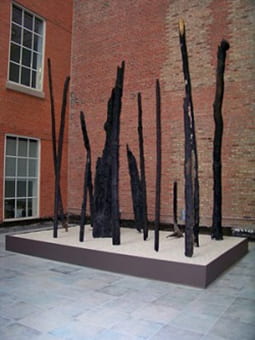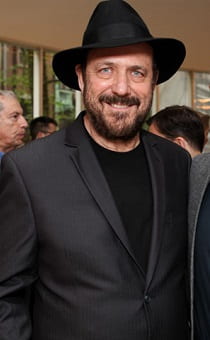Trees of Aspen foregrounds transplanting as an artistic act, a practice that has been central to Sonfist’s work as an ecological artist. Through the careful study, selection, and reintegration of found, organic elements into a sculpture, Sonfist draws our attention to the material’s formal aesthetic qualities as well as its unique ecological lifecycles and properties. Whereas in the nearby work, Ideas of Stone, Italian conceptual artist Giuseppe Penone created a carefully worked artifice that imitates nature, Sonfist, an American artist of the same generation, memorializes organic artifacts to assert nature and natural cycles as art itself. Unlike Penone’s sculpture, which integrates its roots into the lawn to blend into the environment, several trunks of Trees of Aspen stand slightly above their pebble base, exposing the inserted steel supports that prop them upright. The distinction between the sculpture and the base highlights the fact that the wooden trunks have been permanently severed from its original soil, transplanted, and grafted to its new site. Yet, in this sculpture, as with the artist’s broader practice of landscape cultivation, the uprooted tree is not necessarily a symbol of death, but rather a sign of rebirth.
Indeed, the theme of transplanting and new life can be extended to the various sites the sculpture has occupied and the different meanings it has cultivated. Created during Sonfist’s residency at the Anderson Ranch Art Center in Aspen, the work was first sited by the artist nearby on the grounds of a golf club in a clearing next to a living forest of aspen trees. Inserted directly into the grassy terrain with steel rods, the burnt and cracked wood pieces would have stood in contrast to both the densely populated surrounding forest and the carefully manicured golf grounds that carpet the landscape.
When Chicago–based collectors and longtime friends of the artist Paula and Herbert Molner purchased and gifted the work to the Smart Museum, curators added a gravel base to reference the 2008 re–landscaping of the museum’s Vera and A. D. Elden Sculpture Garden, where the work was once proposed to be re–sited. This later addition, which was approved by the artist, not only changed the sculpture but altered its meaning by inscribing it within the context of the re–landscaping. Indeed landscape artist Chandra Goldsmith and UrbanLab’s collaboration to cultivate the urban garden with indigenous plants resonates well with Sonfist’s own practice. Although Trees of Aspen was never successfully sited in the Sculpture Garden, its gravel base inevitably links it to the site, allowing us to think of it as one potential piece of the Garden’s distinctive patchwork of landscapes.
Today, the sculpture sits in the atrium of the Toyota Technological Institute building, an early 20th–century telephone exchange center that has been adaptively reused and renovated to house the Institute and the University’s Information Technologies Services. The publically inaccessible atrium of the Institute seems at first an unlikely and challenging place for a public sculpture, yet Trees of Aspen works with the space in unexpectedly affective ways. The siting creates a fascinating juxtaposition between the organic materials of the sculpture and the highly technological environment: a datacenter where the material ‘stuff’ of our seemingly immaterial digital world lives. Amidst the hub of activity in the building, Trees of Aspen sits in a light–filled, spacious, central atrium, a visual respite, which can be seen from four floors of the building. With its charred bark echoing the black perimeter of tar on the building’s brick walls, the repurposed remains of the once living trees draw attention to the architectural palimpsest visible along the interior courtyard walls.
A testament to the passage of time, the work seems to parallel the building’s own history of obsolescence and rebirth. Built in 1914 by the prominent Chicago architecture firm Holabird and Roche, the building served as a state–of–the–art Illinois Bell telephone switching station lauded then as, “one of the largest telephone exchanges in the world.” Later construction extended the building by adding a fifth floor and three bays on the north side, thereby creating the interior courtyard. Yet by the latter half of the century, the building was abandoned when the technology became obsolete. It wasn’t until 2006, when the University renovated the property, that it was transformed once more into a technology hub for the 21st century. Describing both the sculpture and the building, Richard Bumstead, Associate Director of Campus Environment noted,
It’s a survivor… It’s renewal, repurpose, and rebirth. All of these things work together between the building and the sculpture.
Considered in relation to the history of its site, Trees of Aspen draws an unexpected parallel between the cycles of growth, obsolescence, and renaissance in both nature and technology. Indeed, it is no coincidence that Sonfist, a well–versed horticulturalist, has chosen to memorialize the aspen tree, a fast–growing species that is actually highly resistant to forest fire. Unlike trees that promulgate one seed at a time, a single aspen seed can populate an entire colony of trees. This is because aspen grows rhizomatically as part of an underground network of interconnected roots, each with the potential to sprout new tree shoots at any point. While fire damage might destroy individual tree trunks above ground, the rhizome below ground remains undamaged and capable of continuous regeneration. Like the organic life–processes of the aspen tree, Trees of Aspen also grows rhizomatically, connecting various sites—the original forest in Aspen, Colorado where the trunks’ roots are likely to have continued to flourish, the golf course in Aspen, the Smart Museum’s Sculpture Garden, and the South Side—within a larger interpretive ecology that celebrates the power of regenerative resiliency and the possibilities of new sites and new meanings.
Written by Nancy P. Lin, a doctoral student in the Department of Art History


